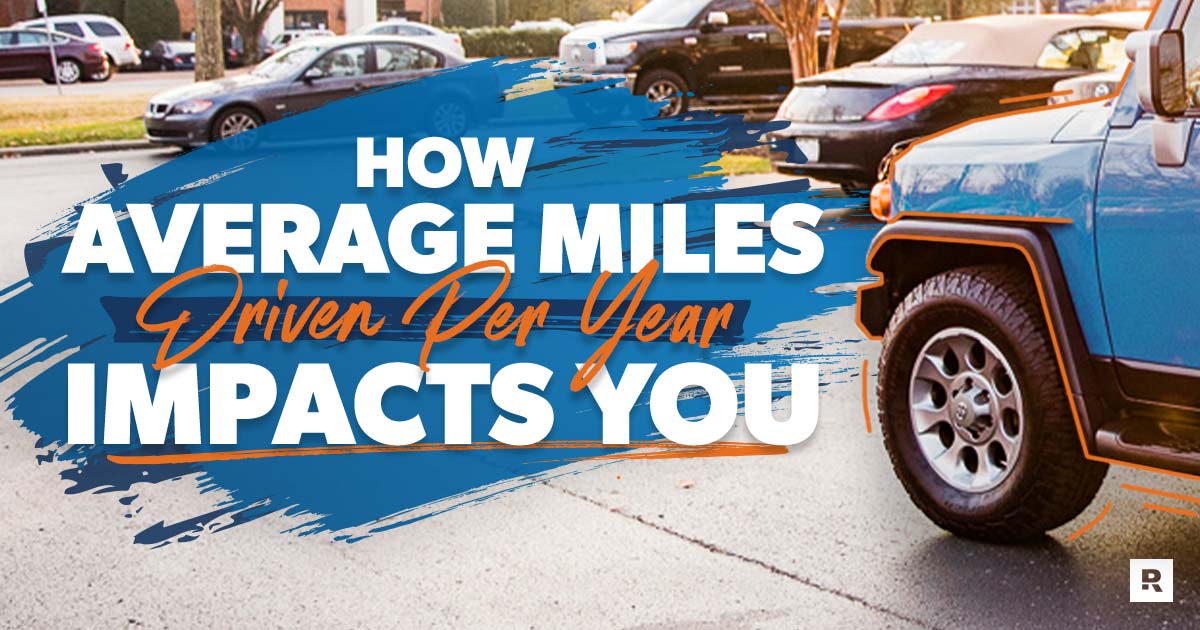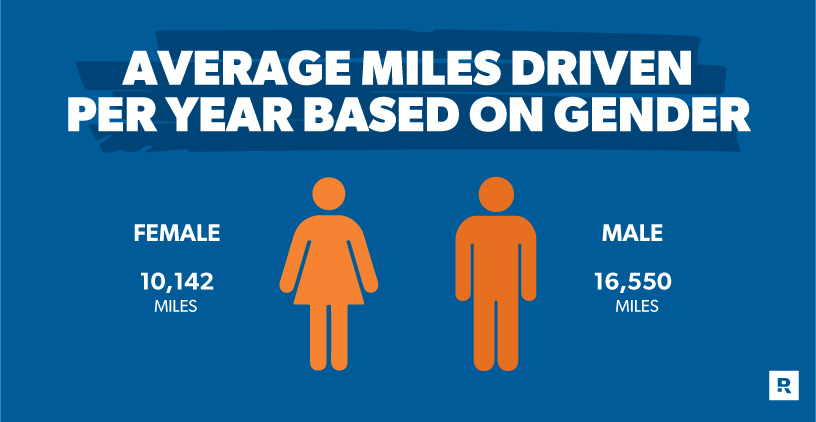How Average Miles Driven Per Year Impacts You
10 Min Read | May 1, 2025

Ever since two bicycle mechanics made the first American car in 1893 (bet you didn’t think it was that early), Americans have been racking up miles on their horseless carriages. While we may not use the word carriage to describe a car anymore (or horseless for that matter), the impact of how many miles you drive makes a big difference in your insurance bill.
Let’s take a look at how average miles driven per year affects your insurance rate and why—as well as a few other fun facts, like who drives the most!
What Factors Impact the Average Miles Driven Per Year on a Car?
Are road trips a family tradition? Do you live an hour away from work? Do you only drive on Sundays and to Aunt Martha’s on Thanksgiving? These are the types of things that will . . . ahem, drive your average miles per year up or down.
Here are the factors that affect average miles driven per year:
Commute
Plenty of people choose to live an hour or more away from their workplace for many reasons—from cheaper housing to better community. But deciding to live farther away from the salt mines will quickly ratchet up that odometer.
Living Location (Rural or Urban)
Do you live in Thermopolis, Wyoming (or Bartlesville, Oklahoma, Eagle Butte, South Dakota, or any other place nobody’s ever heard of)? If so, you’re likely familiar with long drives to reach a grocery store, Walmart or just . . . civilization. This means racking up more miles to do everyday life.
Type of Job
Some jobs require more than just driving to and from work. Freelance filmmakers drive to the ends of the earth to shoot footage for clients. Home health nurses motor all over town visiting patients. Mermaid performers travel from party to party to flick their fins for cash.
Recreational Driving Habits
If you love finding a new outdoor adventure every weekend, traveling to see your family all the time, or road-tripping just for fun, you’ll put more miles on your car.
Age
It should come as no surprise that people drive more at different ages. A 16-year-old who just got his license and has a 10 p.m. curfew won’t be driving as much as the thirtysomething woman at the height of her career.
Gender
Believe it or not, whether you’re a dude or a dudette plays a role in average miles driven per year. We’ll tell you who wins in the section all about it below, but can you guess whose rubber meets the road more?
U.S. Averages for Annual Mileage
The U.S. Department of Transportation (DOT) calculates average annual miles for citizens every year. With one year’s stark exception, annual mileage has been on an upward trend since the 1970s.1 (In 2020, average yearly mileage dropped big time as people were required to stay home or did so voluntarily.)
Do you have the right insurance coverage? You could be saving hundreds! Connect with an insurance pro today!
The only major disruptor over the course of that trend is oil prices. Whenever gas prices spike too high, Americans tend to stick closer to home.
How many miles does the average person drive per year?
If you’re planning on adding up your annual mileage, you may wonder how it’ll stack up against the average Joe. Well, according to the U.S. Department of Transportation, the average American drives 13,476 miles per year.2
What are the average miles per year on a car?
The average person drives about 14,000 miles each year. So average car mileage per year is in that range. Anything over that per year would be considered high mileage for a car. If you share the car with your husband or kid, the car is getting more use so that’ll push the number up.
Knowing how many miles the average person drives a year is helpful when you’re considering purchasing a used car. You can divide the number on the odometer by the age of the vehicle to figure out if the car was driven more than usual.
How many miles does the average car last?
“They don’t make ’em like they used to!” may not be so true when it comes to cars these days. The average vehicle is lasting longer thanks to better parts engineering. These days, the average car lasts about 200,000 miles.3 But you can make them last even longer if you get a high-quality car and take good care of it.
Average Miles Driven per Year Based on Age
Ever seen a granny behind the wheel driving like she hasn’t driven in 50 years? That’s because she probably hasn’t. Alright, maybe it hasn’t been 50 years, but it’s probably been a while.
According to data from DOT, a person’s average miles driven per year changes with age. This has to do with what people are doing at different stages of life. Americans between 35 and 54 years old—when most people are in the middle of jobs and family life—racked up the highest mileage.4

You may find your insurance rates change as you get older and slow down—or get older and speed up (depending on where you’re at). But if your insurance rates don’t go in the direction you’re expecting, keep in mind, miles driven per year isn’t the only factor insurance companies are taking into account.
Average Miles Driven per Year Based on Gender
Turns out about one half of the U.S. population drives more than the other half, and the double yellow line is gender. If you guessed men hit the road more, then you are—drumroll, please . . . correct! Men put in 6,408 more miles behind the wheel than women per year.5

There could be many reasons why any given woman drives less than any given man, but a common one is more women stay at home with kids, which means they’re avoiding those commuting miles.6
Average Miles Driven per Year Based on State
Because different states have different populations, it makes sense states have different average miles driven per year.7

Many of the states clocking the highest miles are rural with lower populations. In fact, Wyoming, which posts the highest average annual mileage, has the smallest population in the union.
If you think about it though, it makes sense. A small group of people spread out over a big chunk of land will have to travel farther to get to each other. Keep that in mind if you’re thinking about moving to the wide open spaces.
Calculating Your Average Miles Driven per Year
If you’ve ever bought insurance, you’ve had to give the company an estimate of how many miles you drive in a year. If you haven’t done this yet (or even if you have), it can be kind of complicated, so we’ll break it down.
First off, this is not going to be accurate down to the quarter mile, so relax. This is an estimate. Second, Google Maps is going to be your best friend for this. Just plug in your start point and destinations to figure out mileage to and from pretty much anywhere.
Think through everywhere you drive in a week. Work? School? Grocery store? Band practice? Church? Tonto National Forest? Write down mileage for anything you do weekly multiplied by 52.
Next, write down anything you do regularly, but not weekly and make a guess at how many times a year you would make this drive. This would include things like recreation, holidays and socializing. Multiply your mileage for each trip by the number of times you think you’ll do it in a year. Add in the total miles for that.
Finally, if you’re planning a big road trip in the coming year, make sure to include that as well.
This total should give you a pretty good idea of your average miles driven per year.
Make sure you include all driving done by all drivers named on your policy. If you share a car with your wife or teen, you’ll need to total up both your miles.
What happens if you exceed your estimated average annual miles driven?
Oh no. Your daughter had a baby in the state over and you ended up making half a dozen trips over and back to help out with the new bundle of joy. This spiked your annual mileage and now you’ve driven well over the estimate you gave your insurance company. Or maybe you just weren’t very good at estimating how much spontaneous leisure travel you do on weekends. What happens now?
Don’t freak out. Insurance companies don’t expect your estimate to be 100% accurate. Depending on how much you went over, you can either wait until you renew your auto policy and update your average annual mileage to reflect the real number or you can contact your provider and let them know you’re driving a lot more than you thought you would.
What Your Average Miles Driven per Year Tells You
Some years might be more, some less, but your average miles driven per year are a good picture of your driving habits. Knowing this number is super helpful when it comes to getting an auto insurance quote (and figuring out how long your car will probably last—and calculating how much you spend in a year on gas).
How Average Miles per Year Impacts Insurance
How much you drive definitely impacts your insurance rate. In fact, like we mentioned earlier, companies make you give them an estimate of your average miles per year before they’ll even give you a quote. Why? Let’s get into it.
What Insurance Companies Consider
Not to throw a math question at you but . . . are you more likely to get in an accident if you drive 700 miles on the road versus 20 miles? The answer, as you know, is yes.
When insurance companies calculate your premium, they’re figuring out how risky it is to cover you (and how likely it is you’ll cost them money). The more time you spend on the road, the more likely you are to be involved in an accident—and the more likely your insurance company will have to pay!
If you drive a lot, insurance companies will charge you higher premiums because they’re taking on more risk. Generally, anything over the U.S. average annual mileage (roughly 14,000 miles) is considered high and will result in a rate hike.
Low Mileage Discounts and Other Savings
But don’t worry, if you’re one of those people who rarely takes your baby out of the garage, you could get a discount. Insurance companies differ on what they consider low and high mileage, so shop around if you think you’re on the line.
Speaking of shopping around, an independent insurance agent is a great way to get the best deal. Because they don’t work for an insurance company, they’re free to work for you and get you the best rate! Get in touch with a RamseyTrusted pro—they can help you find the right insurance for the right price.
Insurance Can Be Confusing. We Have Someone Who Can Help.
RamseyTrusted® insurance pros are independent and vetted—and they help you fill the gaps in your policies. They make getting insurance (like home, auto and umbrella) one less thing to stress about. Plug in your zip code to connect with an agent who understands the coverage needs in your area.


